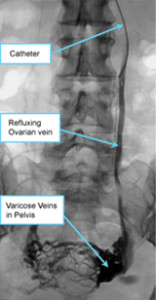Ovarian Vein Embolisation for Pelvic Congestion Syndrome
What is Ovarian Vein Embolisation?
Ovarian Vein Embolisation is an examination of the blood vessels using x-rays and contrast (x-ray dye). A specialist known as an Interventional Radiologist often performs these procedures. The contrast is injected through a thin plastic tube called a catheter, which is passed through a sheath inserted into the femoral vein.
What is Ovarian Vein Embolisation a treatment for?

Ovarian vein embolisation is a minimally invasive treatment for pelvic congestion syndrome that is used to stop blood flow through incompetent veins so they can no longer enlarge with blood, thus relieving the pain.
What is Pelvic Congestion Syndrome?
Pelvic congestion syndrome, also known as ovarian vein reflux, is a painful condition resulting from the presence of varicose veins in the pelvis. The condition is caused by valves in the veins that help return blood to the heart against gravity becoming weakened and not closing properly, allowing blood to flow backwards and pool in the vein causing pressure and bulging veins.
What is the pain most associated with pelvic congestion syndrome?
The chronic pain that is associated with this disease is usually dull and aching. The pain is usually felt in the pelvis and lower back. Pelvic congestion syndrome is sometimes also called chronic pelvic pain.
The pain often increases during the following times:
- Following intercourse
- Menstrual periods
- When tired or when standing (worse at end of day)
- Pregnancy
What are the other symptoms of Pelvic Congestion Syndrome:
- Irritable bladder
- Abnormal menstrual bleeding
- Vaginal discharge
- Varicose veins on vulva, buttocks or thigh
Is there a fact sheet about ovarian vein embolisation and what to expect from the procedure?
Fact Sheet
Ovarian Vein Embolisation Procedure Fact Sheet
Referral Forms
Contact Us
Procedure Enquiry
Author: Dr John Vrazas MB,BS FRANZCR

